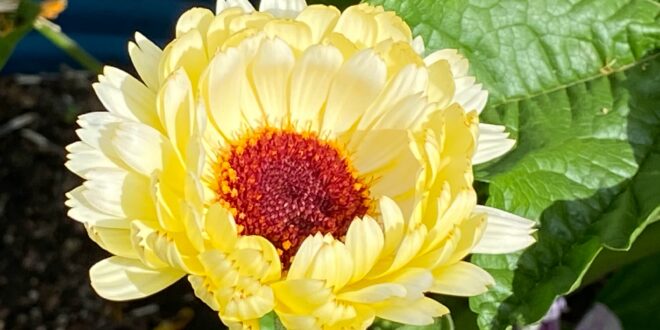This one-of-a-kind Calendula has a neat trick. Yellow flower buds open to reveal white flowers whose backsides are also a butter yellow. The effect is mirage-like, with the 3” white flowers having a shimmering yellow reverse. Large, dark (occasionally white) centers add a vivid contrast to the double rows of silky petals. Highly sought after by bees and butterflies. Quickly forming a multi-branching 2′ plant, this floriferous annual, starts blooming in late spring and never stops. Ideal for adding pizzazz to a sunny bed and compact enough to feature in a container. Makes an excellent cut flower. Plant in fertile, well-drained soil in full sun. Deadhead to prolong blooming. Deer resistant but edible for we humans!
Calendula (Calendula officinalis) is a short-lived perennial in warmer climates, but in cooler climate zones it is usually grown as an annual flower in garden beds and containers. Although commonly known as pot marigold, calendula is different from the common marigold (Tagetes spp.). It is, however, part of the Asteraceae family along with daisies and chrysanthemums, and has a daisy-like appearance. It is planted in spring after the last frost and grows relatively quickly, flowering six to eight weeks from seeding.
The common name of pot marigold originated from the gold flowers that bloomed during the festivals of the Virgin Mary in Renaissance times (mary + gold = marigold). Ancient Greek, Roman, Arabic, and Indian cultures used calendula as a medicinal herb and as a dye for fabrics, food, and cosmetics. Today, gardeners grow these plants for their cheery flowers and profuse blooming habit. Though they most commonly are seen in varieties with yellow, orange, and red flowers, you can also find them in subtle shades of pink and cream.
- Common Name Calendula, pot marigold, common marigold
- Botanical Name Calendula officinalis
- Family Asteraceae
- Plant Type Perennial, annual
- Mature Size 1-2 ft. tall, 1-2 ft. wide
- Sun Exposure Full, partial
- Soil Type Well-drained
- Soil pH Neutral
- Bloom Time Spring, summer, fall
- Flower Color Yellow, orange, red, white, pink
- Hardiness Zones 2a-11b (USDA)
- Native Area Mediterranean
Calendula Care
Calendula is primarily an annual unless you live in hardiness zones 9 to 11, where it can be grown as a perennial.
It is easy to grow from seeds directly sown in the garden or containers. Plant seeds indoors in early spring and repot or transplant sturdy seedlings after the danger of frost has passed. Calendula will tolerate poor conditions but grows best when it has rich soil. Once established, it doesn’t need much water or fertilizer to grow. Calendula is a full sun plant, however, it’s not a fan of sweltering hot temperatures and might start wilting in intense heat.
Pinching back young plants will promote more compact, bushy growth and prevent the plants from becoming leggy. Deadhead the old flowers to encourage reblooming.
Light
Calendula generally prefers full sun, but it sometimes languishes during the hottest months unless it receives some afternoon shade.
Soil
Like most members of the daisy family, calendula needs a well-drained soil high in organic material. Dense, wet soils can cause the roots to rot. This plant tolerates a wide range of soil pH but prefers a slightly acidic to neutral soil (6.0 to 7.0).
Water
Water frequently until the plants are established. Mature plants thrive on only occasional watering. Avoid too much water with these plants.
Temperature and Humidity
Calendula prefers mild summer temperatures and may die away by the end of summer in very hot climates.
A hard freeze will kill the plants. If you expect some frost for a day or so, you can protect the plants with a frost blanket overnight and uncover as the sun warms up the air the next day. Three to four inches of mulch will also protect the plants from cold temperatures.
Fertilizer
Calendula does not need much in the way of feeding. If planted in fertile garden soil, it requires no additional feeding at all. Marginal soils may require feeding with a balanced, water-soluble fertilizer, but over-feeding can make the plants leggy and spindly.
Container plants require monthly feeding with a diluted, balanced fertilizer.








